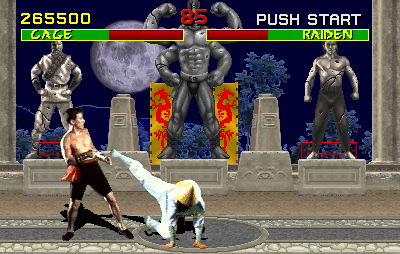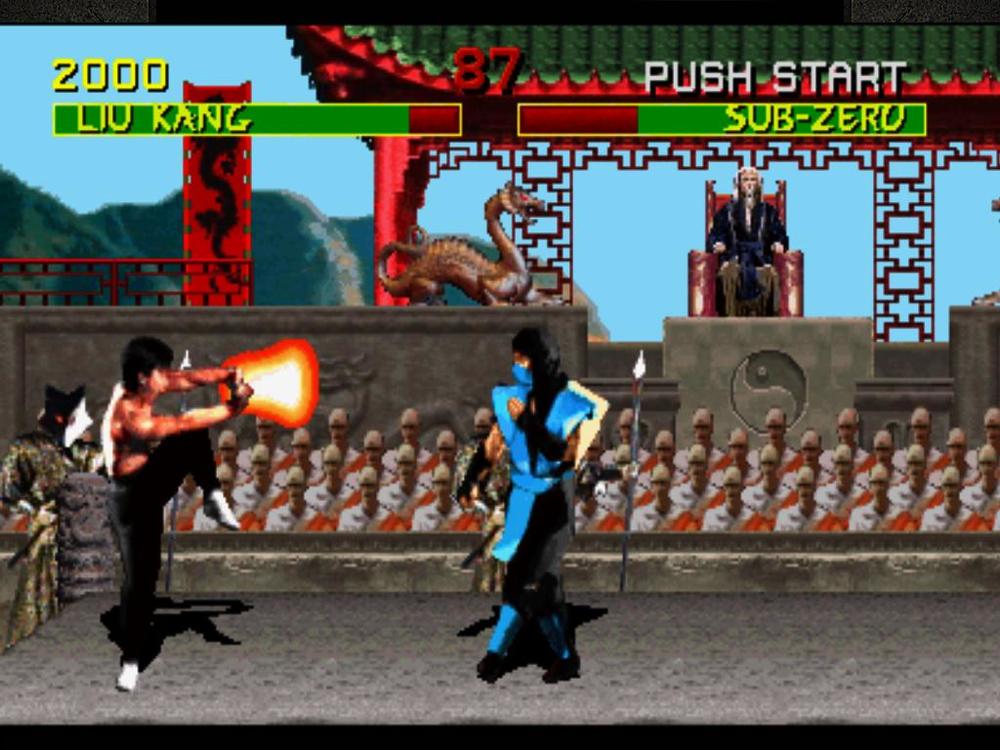
In the early 1990s, the gaming industry was truly on a roll. Graphics were becoming better and better. New ideas were blossoming like flowers on a sunny hillside. Every month, magazines like GamePro showed us new titles and systems on the horizon. The future was bright, and we had our shades on. However, there were also hassles to deal with. Most notable was the conflict over violence and censorship. This issue polarized people, both video gamers and the uninitiated. I’ve written about some of the seminal FPS (first-person shooter) games, like Doom and Wolfenstein 3D, that rose to the top among all this dynamic energy. However, there also emerged a titan amongst fighting games during this era… brutally violent… action packed… and gory beyond belief.

I felt that the original Mortal Kombat was a fitting subject for October, not because it has monsters or wizards in it… but because of all that blood. Released by Midway, Mortal Kombat took the fighter genre by the short-and-curlies, writing a new set of rules and causing a true uproar after its October 1992 release. The game created new standards, became a source of rumor and controversy, and even helped shape games as we know them today.

In Mortal Kombat, you play one of seven fighters chosen from Earth to compete in Shang Tsung’s tournament. His champion, the four-armed half-dragon Goro, hasn’t been defeated in 500 years. Each playable character has their own reasons (some intertwined) for competing and wanting to win. For instance, Sonya is after Kano, and Scorpion seeks revenge on Sub-Zero, while Liu Kang (my personal favorite) just wants to defeat Shang Tsung and bring honor back to the ancient tournament. The plot, like those of most fighting games, takes a backseat, however. Mortal Kombat is mostly about the action, and it delivers. MK’s control scheme was (and still is) more or less unique; five buttons control punches and kicks (both high and low) as well as a block that thwarts your enemy’s strikes. Unlike Street Fighter II and the other competition of the era, every MK character’s regular moves are very similar. Everyone can sweep kick, jump kick, and uppercut… and they all look about the same doing it, and they all do it as well as their peers. The special moves are where you start to see the differences. Many are simply projectiles; Kano, Johnny Cage, Sonya, Liu Kang, and Raiden all have one. Others include Sub-Zero’s freeze attack, Scorpion’s iconic “GET OVER HERE” harpoon, and Liu Kang’s pummeling bicycle kick. Most of the moves are fun and don’t require a surgeon’s hands to pull off effectively, which is nice if you’re not an expert at fighting-style games. However, the same cannot be said for the fatalities.
And fatal they are. A big chunk of what sparked the game’s pet controversy, fatalities are special moves performed on a helpless, defeated opponent. You see, the matches are best-of-three. If you win the second or third round (and therefore the match), a voice calls out “FINISH HIM!” and as Scorpion’s all too glad to demonstrate below…

…and that one’s pretty tame. Spines, guts, hearts, it doesn’t matter; everything’s getting ripped out or off. Nothing is safe.



Players can battle one another ad infinitum, but the winner of such matches will continue on the in-game tournament ladder between challenges from other players. After defeating the other participants in the tournament (singly and then 2-on-1), you are confronted by none other than the champion, Goro. While he’s very strong and even quick, Goro suffers the downfall of so many big brutes in pop culture: he’s just not that clever. Careful exploitation of his size and other limits can help a well-honed fighter bring him down. Once Goro is defeated, there is but one final match… against the shapeshifting, floating evil wizard Shang Tsung. It’s as challenging as it sounds, unless you’re lightning-quick and razor-sharp.

In addition to the normal foes you face, doing certain things a certain way at certain times can bring around Reptile, a secret hidden character who combines the moves of Sub-Zero and Scorpion. It isn’t necessary to beat Reptile to finish the game, but it’s certainly something for the completion nerds to quest after. Less cryptic is the “Test Your Might” minigame, where button-mashing helps you build up the strength to smash through various materials (from wood to diamond) and add points to your score.

The game’s graphics are stellar for reasons similar to 1993’s Doom: lots of the art is digitized photography or meticulously crafted digital art. As you will see in parts of the behind-the-scenes video below, every fighter was posed and scanned into the game using a painstaking (and long) process.
The Sound is all digital too, with plenty of screams and howls to further depict the agony of martial arts mayhem. There is music, but it is very appropriately low-key during gameplay. It mostly consists of heavy drums and orchestra hits, the kind of music you’d expect when two people decide to beat the shit out of each other in the 1990s. However, an official album was released in 1994, with a theme for each character as well as other music inspired by the game.
Along with many of its contemporaries in the early 90s, Mortal Kombat came under fire in the conflict between concerned parents and anti-censorship interests. Mortal Kombat was one of the games examined during the 1992-93 hearings held by senators Joseph Lieberman and Herb Kohl regarding concerns over video game violence. The game came under special scrutiny due to the combination of realistic-looking characters and “excessive” gore. Ultimately, this led to several of its console system ports having the blood removed (although a code could get you blood in the Genesis version). In addition, the arcade version had been designed with a dipswitch to turn the blood on and off so the game could be used in multiple types of environments without issues. None of the controversy hurt Mortal Kombat’s popularity as a game or as a franchise; two sequels were out by 1995, as well as a film and even some action figures (made by Hasbro, in the exact style of GI Joe figures). The original game and its sequels were ported to nearly every home or portable system of the time period, with even the Game Boy getting a version. Some of these were missing the blood and/or a couple of characters, but they were mostly playable.

I give Mortal Kombat 9 stars out of 10. It’s archaic now, but when it erupted onto the scene in 1992, it changed EVERYTHING. It’s always been one of my personal favorites, both this individual game and the series as a whole.
Now for some fun trivia!
Actor and martial artist Daniel Pesina portrays three (four) different characters in the game: Johnny Cage, Scorpion, and Sub-Zero (and thus, by extension, Reptile). Ho Sung Pak plays not only Liu Kang, but also the main villain, Shang Tsung. The ninja suit used to capture Sub-Zero and Scorpion’s moves was red, not blue or yellow. As a neat side note, Ho Sung Pak also worked on the TMNT films in various roles.
According to interviews and other sources, the game was originally supposed to be very different and revolve around Jean-Claude Van Damme, popular 1990s martial-arts movie star. Since Van Damme was already involved in a similar project (which was never made), the concept was changed dramatically, but the idea to digitize the actors was retained. Character Johnny Cage is loosely based off Van Damme, and his signature split-plus-groin-punch move is an homage to the film “Bloodsport.”
Reptile sparked rumors of another hidden character, a red ninja called Ermac. His existence was theorized about due to the diagnostics menu “ERMACS” (error macros) that would show up on the game’s debug screen. Midway said nothing on the issue for a long time… but added just such a character in a later game (Ultimate Mortal Kombat 3).
The Sega Genesis version was bloodless unless you pressed A-B-A-C-A-B-B at the start. It was given an MA-13 rating. The Sega CD version was fully uncensored, which earned it an MA-17 rating. Along with the Splatterhouse sequels, this game was among the first titles that Sega rated with its own system shortly before the ESRB took full effect.

There’s more coming just before Halloween, RetroMonsters! We’ll close out the month by celebrating one of the true legends of horror gaming. See you then!



